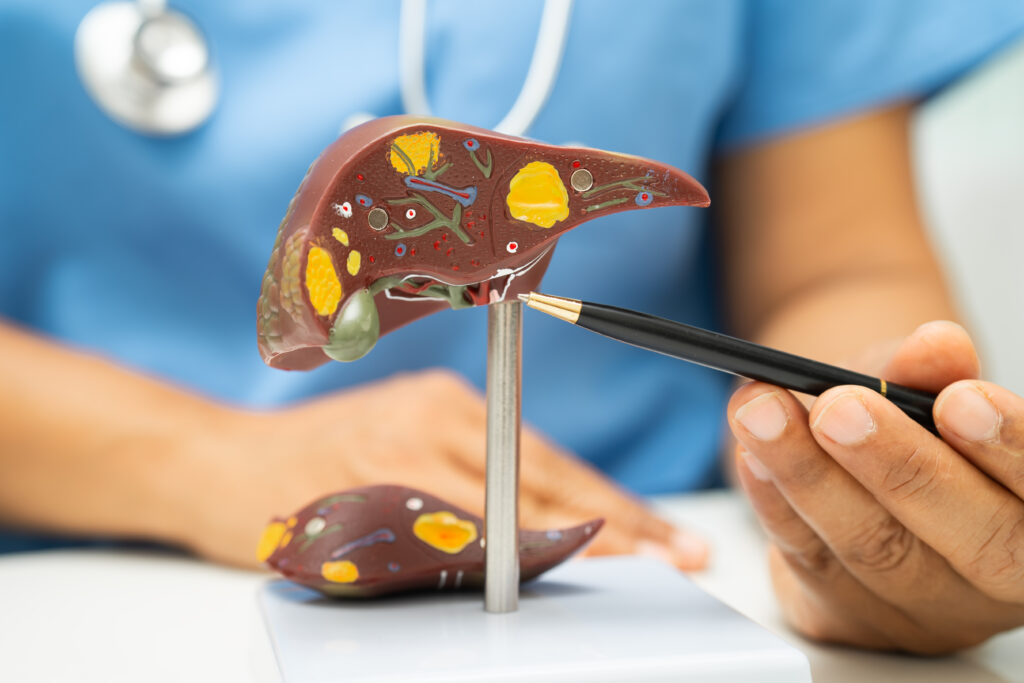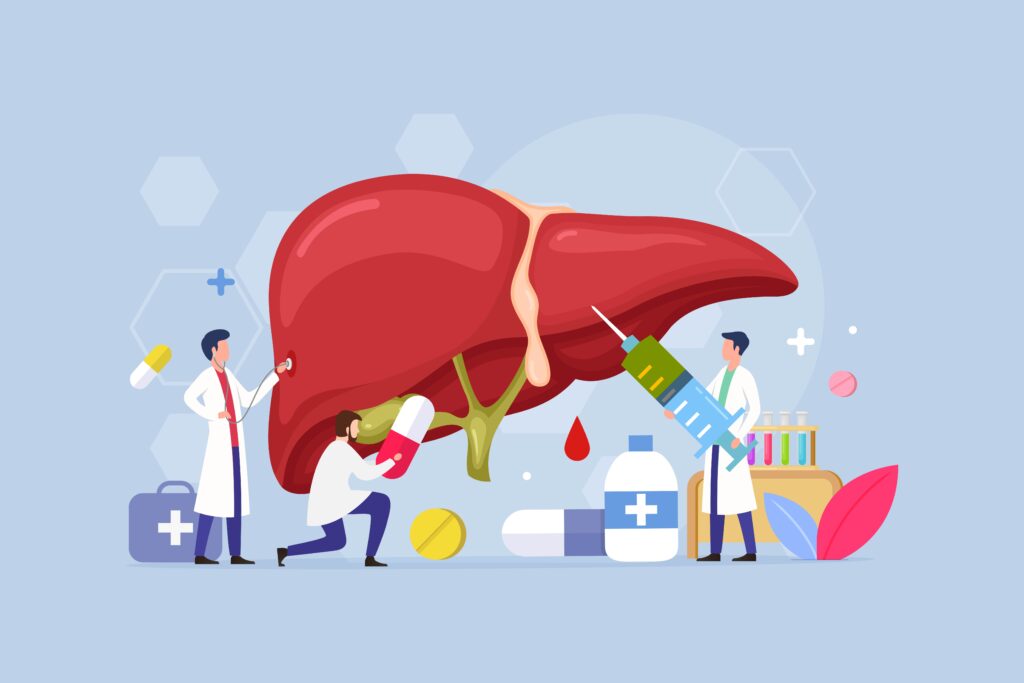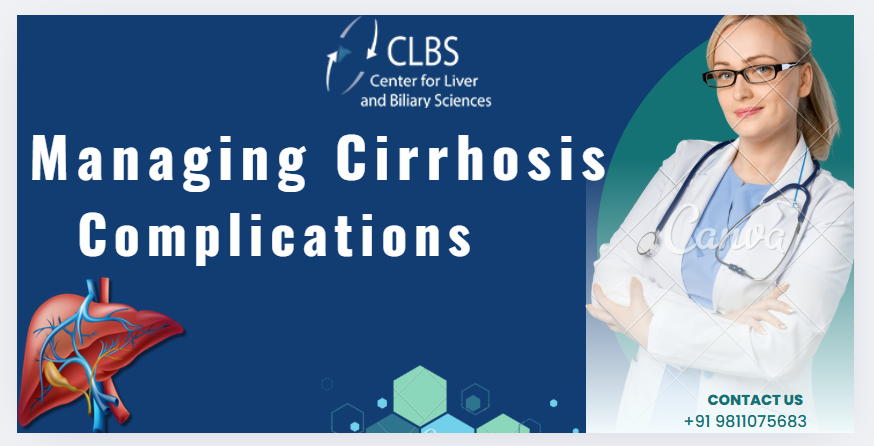Cirrhosis is the end stage of chronic liver disease, where irreversible scarring leads to impaired liver function. As the liver is progressively damaged, complications like ascites, hepatic encephalopathy, and varices may develop, having a considerable impact on a patient’s quality of life. Knowledge of these complications and management is important for patients with cirrhosis.
Understanding Cirrhosis and Its Pathophysiology

Liver Cirrhosis is a consequence of chronic liver injury from causes such as chronic alcoholism, viral hepatitis (hepatitis B and C), non-alcoholic fatty liver disease (NAFLD), and autoimmune diseases. The inflammation and fibrosis in the liver from chronic injury result in scar tissue formation. Scarring deforms the architecture of the liver and obstructs blood flow, resulting in portal hypertension—a state where portal vein blood pressure increases. Portal hypertension is the underlying mechanism behind most complications of cirrhosis, such as ascites, varices, and hepatic encephalopathy.
Ascites: Abdominal Fluid Accumulation
Pathophysiology:
Ascites happens when there’s fluid accumulation in the peritoneal space as a result of portal hypertension and hypoalbuminemia (reduced albumin in the blood). This fluid accumulation may cause discomfort, shortness of breath, and chances of infections such as spontaneous bacterial peritonitis (SBP).
Management:
Sodium Restriction: Low-sodium diet (fewer than 2 grams a day) is necessary to avoid fluid retention. Dietary alteration reduces ascitic fluid volume and symptoms.
Diuretics: Spironolactone (an aldosterone blocker) and furosemide (a loop diuretic) are the medications most frequently used to facilitate fluid excretion. Together, these diuretics work well for ascites treatment.
In the situation of tense ascites that’s uncomfortable or which causes respiratory problems, immediate relief can be brought about by paracentesis, or the removal of excess fluid from the abdomen. Albumin can be given after this intervention to avoid circulatory failure.
Transjugular Intrahepatic Portosystemic Shunt (TIPS): For that refractory ascites unresponsive to medical treatment, TIPS can be offered. The procedure opens up a passageway through the liver to decompress the portal pressure and regulate fluid status. TIPS carries with it the added risk of hepatic encephalopathy and is reserved for those usually well-selected.
Hepatic Encephalopathy: Defective Brain Function

Pathophysiology
Hepatic encephalopathy (HE) is caused by the accumulation of toxins, especially ammonia, in the blood secondary to liver failure. Toxins are able to pass through the blood-brain barrier and impair brain function, and present with symptoms from mild confusion to coma.
Management:
Lactulose: This non-absorbed disaccharide lowers ammonia levels by acidifying the colon and inducing the excretion of ammonia in the stool.
Rifaximin: An antibiotic that suppresses the synthesis of ammonia by gut flora, rifaximin is frequently used in combination with lactulose to avert recurrent HE.
Identification and Management of Precipitating Factors:
Infections, gastrointestinal bleeding, electrolyte derangements, and constipation are common precipitating factors of HE. These underlying causes are important to be addressed in treating HE.
Dietary Adjustments: Although protein restriction used to be common practice, contemporary guidelines recommend that sufficient protein supply is necessary in order to avoid malnutrition but should be strictly chosen and its intake possibly be reduced during bouts of HE.
Varices: Dilated Blood Vessels Prone to Bleeding
Pathophysiology:
Varices are enlarged veins, typically in the stomach or esophagus, caused by portal hypertension, or increased pressure in the portal vein. Varices are weak and easily ruptured, with the potential for fatal bleeding.
Treatment:
Screening: Cirrhotic patients need to be screened regularly by endoscopy to diagnose varices, particularly if they have severe liver disease or other risk factors.
Primary Prophylaxis: In medium or large varice patients, non-selective beta-blockers (e.g., propranolol) may decrease portal pressure and the risk of bleeding.
Endoscopic Band Ligation (EBL): In patients with high-risk or large varices, EBL is done to avoid bleeding by putting bands around the varices to cut off blood flow.
Acute Bleeding Management: In case of variceal hemorrhage, urgent management involves resuscitation with IV fluids and blood products, administration of vasoactive medication (e.g., terlipressin), and endoscopic treatments such as EBL or sclerotherapy. If bleeding is ongoing, TIPS or surgery will be required.
Nutritional Issues in Cirrhosis

Dietary Changes:
Protein Intake: Sufficient protein is necessary to avert muscle loss. When there are episodes of HE, however, protein may require adjustment.
Caloric Intake: Increased caloric intake is required to compensate for the body’s energy needs and avoid malnutrition.
Sodium Restriction: Reducing sodium consumption aids in ascites and fluid retention control.
Avoiding Alcohol and Toxins: Avoidance of alcohol and hepatotoxic substances is important in avoiding continued liver injury.
Supplementation:
Vitamins and Minerals: Vitamin supplementation with B-complex, D, and K, as well as zinc, may be required because of impaired metabolism and absorption in cirrhosis.
Branched-Chain Amino Acids (BCAAs):
BCAAs may assist in the preservation of muscle mass and nutritional status among cirrhotic patients.
Dietitian Consultation: Collaboration with a registered dietitian can assist in individualization of diet plans, taking into account comorbidities and treatment protocols.
Patient Education and Support
Education of patients is crucial to the successful management of their condition. Education must address:
Symptom recognition: Knowledge of early warning signs of complications such as ascites, HE, and variceal bleeding can result in early medical care.
Follow-through with Treatment Regimens: Compliance with medication use and diet guidelines is imperative.
Lifestyle Changes: Avoidance of alcohol, weight management, and proper physical exercise can enhance outcomes.
Access to Assistance: Participation in support groups and counseling can offer emotional support and concrete advice for managing the difficulties of cirrhosis.
The complications of cirrhosis—ascites, hepatic encephalopathy, and varices—must be managed by an integrated strategy combining medical care, lifestyle adjustments, and patient education. Detection at an early stage and prompt intervention are important in preventing the worsening and enhancing the quality of life. Partnership between patients and physicians ensures best
Cirrhosis may result in severe complications such as ascites, hepatic encephalopathy, and varices that need proper management to safeguard your health. Knowing what these conditions are, if you have cirrhosis, enables you to identify them at an early stage and collaborate with your healthcare providers to avoid worsening. Ascites is fluid accumulation in your abdomen, encephalopathy impacts your brain function, and varices are dilated veins that can bleed. By adhering to medical recommendations, adjusting lifestyle, and staying educated, you can improve your quality of life and better control these complications.
Key Takeaways:
- Manage and monitor ascites with sodium restriction, diuretics, and therapeutic paracentesis as indicated.
- Manage hepatic encephalopathy by recognizing precipitating factors, employing lactulose or rifaximin, and monitoring mental status regularly.
- Screen for varices with endoscopy in at-risk patients and prevent bleeding with beta-blockers or band ligation.
- Maintain fluid and electrolyte balance to prevent complications such as renal dysfunction or hyponatremia.
- Coordinate care with a multidisciplinary team to optimize treatment and enhance patient outcomes.
Understanding Cirrhosis
Before diving into the intricacies of cirrhosis, it’s essential to understand what cirrhosis is and how it occurs. Cirrhosis is the final stage of chronic liver disease, where scar tissue replaces healthy liver tissue, making your liver unable to function. With time, this scarring interferes with blood flow and metabolic functions, causing severe health complications. Identifying the early symptoms and root causes can assist you in controlling or even halting its development.
Definition and Causes
Below, you’ll find a clear explanation of cirrhosis and its common causes. Cirrhosis is a condition marked by irreversible scarring of the liver, often resulting from long-term damage due to hepatitis, excessive alcohol use, or fatty liver disease. Your liver’s ability to detoxify blood, produce proteins, and aid digestion becomes compromised as scar tissue replaces healthy cells.
Chronic alcoholism, viral hepatitis (Hepatitis B and C), and non-alcoholic fatty liver disease (NAFLD) are some of the most common causes. Autoimmune diseases, genetic conditions such as hemochromatosis, and exposure to toxins for a long time are other factors. Knowing these causes can guide you to take measures to save your liver or get appropriate treatment in time.
Pathophysiology of Cirrhosis
At the center of cirrhosis is a multifaceted process of injury and repair. When your liver is chronically injured—either by toxins, infection, or inflammation—it causes your liver to heal. Rather than growing back healthy tissue, your liver produces fibrous scar tissue, which distorts its normal architecture and function. Scarring impedes blood flow, causing pressure to build in the portal vein (portal hypertension) and additional complications.
As cirrhosis advances, your liver’s capacity to remove toxins decreases, leaving toxic substances such as ammonia to accumulate in your blood. This can impair your brain, kidneys, and other organs. Destruction of functional liver cells also disrupts the production of proteins, making clotting factors less effective and enhancing your risk of bleeding.
Cirrhosis remodels the microscopic structure of the liver into regenerating cell nodules within a dense fibrous scar. This structural alteration decreases liver function in addition to impeding medication action. Progressively, damage that accumulates results in failure of the liver, highlighting the necessity for intervention early and behavioral modifications.
Ascites Management
Obviously, treating ascites in cirrhosis must be done in a structured way to remove symptoms and avoid complications. Ascites happens when fluid builds up inside your abdomen because of portal hypertension and low albumin. Your healthcare professionals will work at lowering sodium in your diet, with diuretics, and, where severe, with therapeutic paracentesis to drain excess fluid. It is essential to watch your weight and kidney function to modify treatment and prevent over-diuresis, which can make your condition worse.
Left untreated, ascites can lead to infections like spontaneous bacterial peritonitis (SBP) or kidney dysfunction. You’ll need regular follow-ups to assess fluid retention and adjust medications. If diuretics aren’t effective, your doctor may recommend a transjugular intrahepatic portosystemic shunt (TIPS) to reduce portal pressure. Lifestyle modifications, including alcohol cessation and a low-sodium diet, play a key role in slowing disease progression.
Diagnosis of Ascites
In the context of cirrhosis, the diagnosis of ascites starts with a physical examination for fluid wave or shifting dullness. Your physician will then probably request an abdominal ultrasound to verify fluid presence and measure its amount. Bloodwork, such as serum albumin and creatinine, aids in assessing renal and liver function, and paracentesis can be done to check the fluid for infection or cancer.
If you have refractory ascites, other imaging such as CT or MRI may be required to eliminate other causes. Your doctor will also screen for hepatic encephalopathy or varices, since these usually occur with ascites. Early diagnosis permits early intervention, decreasing the risk of complications and increasing your quality of life.
Treatment Options
Against ascites challenge, first-line management includes diet sodium restriction and diuretics such as spironolactone and furosemide. Your physician will adjust the dosage according to your response and kidney function. Should you develop tense ascites that results in discomfort or breathing, therapeutic paracentesis offers immediate relief, although albumin infusion might be necessary to avoid circulatory dysfunction.
For refractory or recurrent cases, TIPS or liver transplantation can be used. TIPS reduces portal pressure, decreasing fluid buildup, but is not ideal if you have severe hepatic encephalopathy or liver failure. Liver transplantation is still the ultimate treatment for advanced cirrhosis, which treats the underlying cause of ascites. Your treatment will be based on the severity of your condition and your overall health.
Actually, treatment with medicine in addition to changing lifestyle is optimum. You need to restrict sodium intake to below 2 grams a day and not consume alcohol at all. Periodic checkup ensures that your treatment continues to be effective, and if required, you can make modifications. Close cooperation with your care team enables you to control ascites and stabilize.
Encephalopathy Management
Now, managing hepatic encephalopathy (HE) is a key aspect of cirrhosis care, as it significantly impacts your quality of life. HE occurs when toxins like ammonia build up in your bloodstream due to liver dysfunction, affecting brain function. Early intervention can prevent worsening symptoms and reduce hospitalizations. Your healthcare team will focus on identifying triggers, such as infections or electrolyte imbalances, while implementing strategies to lower toxin levels and improve mental clarity.
Identifying Symptoms
In addition to physical complications, cirrhosis can produce subtle changes in cognition that will worsen if left untreated. You may experience confusion, forgetfulness, or difficulty concentrating at first. When HE advances, symptoms may include slurred speech, personality alterations, or even drowsiness. If you or a caregiver notice these symptoms, seeking immediate medical evaluation allows for timely treatment to reverse or stabilize the condition.
Therapeutic Strategies
One of the main objectives of HE management is lowering levels of ammonia, normally done with drugs such as lactulose or rifaximin. Lactulose reduces ammonia by bringing it to the colon, where it is flushed out, and rifaximin attacks the toxins-producing bacteria of the gut. Your physician can also suggest changes in diet, including reducing protein intake during an attack, to reduce ammonia production. Following these therapies can maintain brain function and avoid relapse.
Long-term HE management includes continuous monitoring and treatment of underlying precipitants, like infections or dehydration. Consistency with medication and follow-up appointments enables your healthcare providers to modify therapy accordingly. Active management of HE helps to minimize its day-to-day effects and allows you to enjoy better overall health.
Managing Varices
Remember that varices—swollen veins in your stomach or esophagus—are a severe complication of cirrhosis. Varices can burst and cause life-threatening bleeding. Getting them detected early and managed ahead of time can help lower your risk. Your medical team will help you monitor and treat varices before they become an emergency.
Risk Assessment
About 50% of people with cirrhosis develop varices, so regular screening is crucial. Your doctor may recommend an endoscopy to check for varices and assess their size and risk of bleeding. If you have advanced liver disease or other risk factors like high portal pressure, you’ll likely need more frequent evaluations. Knowing your risk helps tailor your treatment plan.
Prevention and Treatment
At the time of diagnosis, your physician might prescribe beta-blockers such as propranolol or carvedilol to decrease portal pressure and minimize the risk of bleeding. In the case of large or high-risk varices, endoscopic band ligation (EBL) could be advised to restrict them before they burst. These procedures can greatly enhance your prognosis when coupled with frequent follow-ups.
Another choice in avoiding bleeding is making lifestyle changes, including staying away from alcohol and NSAIDs, which may complicate portal hypertension. When there is bleeding, emergency procedures like sclerotherapy or a TIPS are utilized. Following all of your appointment schedules and staying adherent with your plan will assist you in controlling this complication successfully.
Nutritional Considerations
Your nutritional needs change significantly when managing cirrhosis, as your liver’s ability to process nutrients becomes compromised. A well-balanced diet can help slow disease progression, reduce complications, and improve your overall quality of life. Focus on consuming adequate protein to prevent muscle wasting while avoiding excessive sodium to minimize fluid retention. Your healthcare provider may also recommend specific adjustments based on your individual condition and complications.
Dietary Modifications
One of the key steps in cirrhosis management is to modify your diet to aid the liver and avoid further injury. You need to restrict sodium consumption to below 2,000 mg daily to minimize the risk of ascites and swelling. Frequent small meals with plenty of lean protein, whole grains, and vegetables can provide adequate energy without straining your liver. Processed foods, alcohol, and excessive fats should be avoided since they will exacerbate inflammation of the liver.
One of the most important aspects of dietary changes is making sure you are getting enough calories to avoid malnutrition, which is a frequent problem in cirrhosis. Your body can have trouble absorbing nutrients, so eating foods that are easy to digest such as eggs, fish, and milk can be helpful. Work very closely with a dietitian to create a meal plan that is customized to your needs, particularly if you have other conditions such as diabetes or kidney disease.
Supplementation
At different levels of cirrhosis, you might need supplements to fill in the gaps and maintain liver function. Vitamins like B-complex, D, and K are commonly advised, given that your impaired liver function might result in compromised absorption. Zinc supplementation might also be suggested to keep encephalopathy symptoms under control by lowering the amount of ammonia circulating in your blood.
Throughout various cases, your physician may recommend branched-chain amino acids (BCAAs) to maintain muscle mass and boost energy levels. Self-medicating with supplements is dangerous, though, so always check with your healthcare team before incorporating anything into your program. They can track your levels and make adjustments according to your progress and lab values.
Given the possible interactions of supplements with medications, it is important to keep your healthcare provider in the know about any additions to your regimen. Iron or vitamin A is an example of some supplements that are toxic in overdose for patients with liver disease. On a regular basis, blood tests can allow for a safe and effective supplementation regimen for your individual needs.
Patient Education and Support
Patient education and support are crucial for successful management of complications of cirrhosis such as ascites, encephalopathy, and varices. Knowledge about your disease enables you to pick up early warning signs, comply with treatment protocols, and make sound lifestyle decisions. Your health care professionals can offer individualized advice, but your active involvement is necessary to enhance outcomes and ensure optimal quality of life.
Support groups and counseling may also assist you and your caregivers in dealing with the emotional and practical aspects of cirrhosis. Talking with others who have similar experiences can alleviate feelings of loneliness and give you useful information about navigating daily life with this disease.
Importance of Patient Engagement
In the context of a multifaceted illness such as cirrhosis, your involvement in your own care can have an impact on your trajectory of health. By being well-informed and communicating with your health-care providers openly, you can more effectively manage treatment plans and steer clear of complications.
Being an active participant in your care also includes following dietary limitations, medication regimens, and follow-up visits. Your diligence in these actions stabilizes your condition and slows disease progression, allowing you to have more control over your well-being.
Resources for Patients and Caregivers
A variety of resources exist to support you and your caregivers in controlling cirrhosis complications. Valid organizations such as the American Liver Foundation and Mayo Clinic provide education materials, internet tools, and hotlines to respond to your questions. They can demystify medical terms and give hands-on advice on managing on a daily basis.
Your medical practitioner can also provide you with local support groups or telehealth options for continuous counseling. Utilizing these resources means that you are getting reliable information as well as having a network of professionals who can relate to your specific needs.
Actually, most clinics and hospitals offer special programs for liver disease patients, such as nutrition counseling and mental health counseling. Investigating these possibilities can further increase your chances of controlling cirrhosis and overall well-being.
FAQ
Q: What is ascites and how is it treated in patients with cirrhosis?
A: Ascites is the accumulation of fluid in the abdomen, usually secondary to liver cirrhosis. Treatment is with a low-sodium diet, diuretics such as spironolactone and furosemide, and, in more severe cases, therapeutic paracentesis (removal of fluid). Complications such as infection or kidney problems are prevented by regular monitoring.
Q: How does hepatic encephalopathy arise, and what treatments are available?
A: Hepatic encephalopathy results from the buildup of toxins, notably ammonia, in the brain as a consequence of liver impairment. Lactulose to slow down the absorption of ammonia and antibiotics such as rifaximin are used to treat it. Management of precipitating factors, e.g., infections or constipation, is also crucial.
Q: What are varices, and how can bleeding be prevented in cirrhosis patients?
A: Varices are dilated veins in the stomach or esophagus that may bleed and rupture. Prevention involves beta-blockers (e.g., propranolol) to decrease pressure and endoscopic band ligation for high-risk varices. Avoiding alcohol and NSAIDs decreases risk of bleeding.
Q: Under what circumstances should a patient with cirrhosis present to emergency services with ascites or encephalopathy?
A: Severe abdominal pain, fever (indications of infection), confusion, or drowsiness that rapidly gets worse requires immediate medical care. These could be signs of spontaneous bacterial peritonitis or serious encephalopathy that must be treated promptly.
Q: Can dietary changes manage complications of cirrhosis?
A: Yes. Low sodium intake decreases fluid accumulation in ascites, whereas sufficient protein preserves muscle mass. Frequent small meals and restriction of processed food enhance liver function. Individualized dietary guidelines can be recommended by a healthcare provider.
Final Words
Keeping this in mind, the treatment of complications of cirrhosis—ascites, encephalopathy, and varices—calls for proactive management of your condition. By following medical advice, observing your symptoms, and incorporating necessary lifestyle changes, you can greatly enhance your quality of life. Your healthcare provider has a crucial role in formulating your treatment regimen, but your dedication to following their guidance is equally essential in curbing disease progression.
Being aware of your condition gives you the power to identify early warning signs and access timely intervention. Whether it is restricting sodium to manage ascites, adhering to prescribed medications to avoid encephalopathy, or receiving regular screenings for varices, every action you take leads to improved outcomes. Your actions today can help reduce risks and keep you as healthy as possible with cirrhosis.

